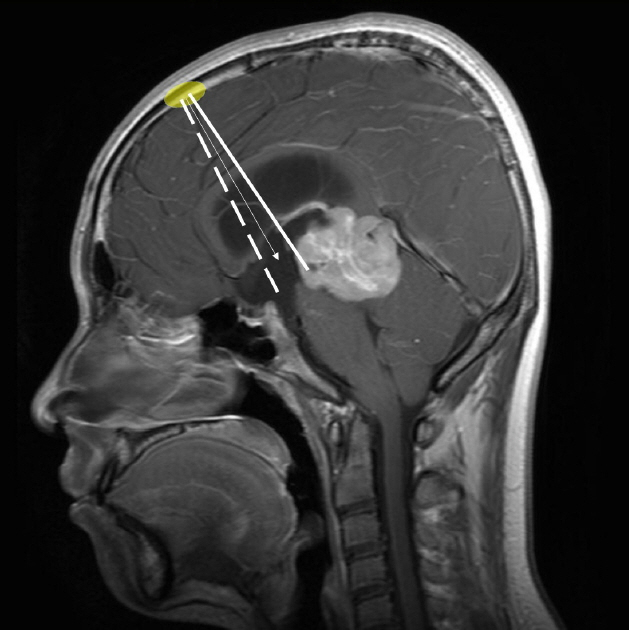J Korean Neurosurg Soc.
2017 May;60(3):282-288. 10.3340/jkns.2017.0101.014.
Prevention of Complications in Endoscopic Third Ventriculostomy
- Affiliations
-
- 1Department of Neurosurgery, Chonnam National University Medical School and Hwasun Hospital, Hwasun, Korea.
- 2Division of Pediatric Neurosurgery and Clinical Pediatric Neuroscience Center, Seoul National University Children's Hospital, Seoul, Korea. kcwang@snu.ac.kr
- 3Department of Anatomy, Seoul National University College of Medicine, Seoul, Korea.
- 4Department of Neurosurgery, Chonnam National University Medical School and Hospital, Gwangju, Korea.
- KMID: 2382761
- DOI: http://doi.org/10.3340/jkns.2017.0101.014
Abstract
- A variety of complications in endoscopic third ventriculostomy have been reported, including neurovascular injury, hemodynamic alterations, endocrinologic abnormalities, electrolyte imbalances, cerebrospinal fluid leakage, fever and infection. Even though most complications are transient, the overall rate of permanent morbidity is 2.38% and the overall mortality rate is 0.28%. To avoid these serious complications, we should keep in mind potential complications and how to prevent them. Proper decisions with regard to surgical indication, choice of endoscopic entry and trajectory, careful endoscopic procedures with anatomic orientation, bleeding control and tight closure are emphasized for the prevention of complications.
MeSH Terms
Figure
Reference
-
References
1. Abtin K, Thompson BG, Walker ML. Basilar artery perforation as a complication of endoscopic third ventriculostomy. Pediatr Neurosurg. 28:35–41. 1998.
Article2. Anandh B, Madhusudan Reddy KR, Mohanty A, Umamaheswara Rao GS, Chandramouli BA. Intraoperative bradycardia and postoperative hyperkalemia in patients undergoing endoscopic third ventriculostomy. Minim Invasive Neurosurg. 45:154–157. 2002.
Article3. Baykan N, Isbir O, Gercek A, Dagcnar A, Ozek MM. Ten years of experience with pediatric neuroendoscopic third ventriculostomy: features and perioperative complications of 210 cases. J Neurosurg Anesthesiol. 17:33–37. 2005.4. Bernard R, Vallee F, Mateo J, Marsella M, George B, Payen D, et al. Uncontrollable high-frequency tachypnea: a rare and nearly fatal complication of endoscopic third ventriculostomy: case report and literature review. Minim Invasive Neurosurg. 53:270–272. 2010.
Article5. Bhagwati S, Mehta N, Shah S. Use of endoscopic third ventriculostomy in hydrocephalus of tubercular origin. Childs Nerv Syst. 26:1675–1682. 2010.
Article6. Bouras T, Sgouros S. Complications of endoscopic third ventriculostomy. J Neurosurg Pediatr. 7:643–649. 2011.
Article7. Bouras T, Sgouros S. Complications of endoscopic third ventriculostomy. World Neurosurg. 79(Suppl):S22.e9–e12. 2013.
Article8. Chong S, Lee JY, Kim SK, Phi JH, Wang KC. Individualized ventricular access using multi-plane brain images. Childs Nerv Syst. 27:299–302. 2011.
Article9. Cinalli G, Sainte-Rose C, Chumas P, Zerah M, Brunelle F, Lot G, et al. Failure of third ventriculostomy in the treatment of aqueductal stenosis in children. J Neurosurg. 90:448–454. 1999.
Article10. Cinalli G, Maixner W, Sainte-Rose C. Pediatric Hydrocephalus. Milano: Springer Science & Business Media;2012. p. 138–140.11. de Kunder SL, Ter Laak-Poort MP, Nicolai J, Vles JS, Cornips EM. Fever after intraventricular neuroendoscopic procedures in children. Childs Nerv Syst. 32:1049–1055. 2016.
Article12. Grand W, Leonardo J, Chamczuk AJ, Korus AJ. Endoscopic third ventriculostomy in 250 adults with hydrocephalus: Patient selection, outcomes, and complications. Neurosurgery. 78:109–119. 2016.13. Grunert P, Charalampaki P, Hopf N, Filippi R. The role of third ventriculostomy in the management of obstructive hydrocephalus. Minim Invasive Neurosurg. 46:16–21. 2003.
Article14. Handler MH, Abbott R, Lee M. A near-fatal complication of endoscopic third ventriculostomy: Case report. Neurosurgery. 35:525–527. discussion 527–528. 1994.15. Hayashi N, Endo S, Hamada H, Shibata T, Fukuda O, Takaku A. Role of preoperative midsagittal magnetic resonance imaging in endoscopic third ventriculostomy. Minim Invasive Neurosurg. 42:79–82. 1999.
Article16. Hopf NJ, Grunert P, Fries G, Resch KD, Perneczky A. Endoscopic third ventriculostomy: outcome analysis of 100 consecutive procedures. Neurosurgery. 44:795–804. discussion 804–806. 1999.
Article17. Hwang SW, Al-Shamy G, Whitehead WE, Curry DJ, Dauser R, Luerssen TG, et al. Amenorrhea complicating endoscopic third ventriculostomy in the pediatric age group. J Neurosurg Pediatr. 8:325–328. 2011.
Article18. Isaacs AM, Bezchlibnyk YB, Yong H, Koshy D, Urbaneja G, Hader WJ, et al. Endoscopic third ventriculostomy for treatment of adult hydrocephalus: long-term follow-up of 163 patients. Neurosurg Focus. 41:E3. 2016.
Article19. Kawsar KA, Haque MR, Chowdhury FH. Avoidance and management of perioperative complications of endoscopic third ventriculostomy: the Dhaka experience. J Neurosurg. 123:1414–1419. 2015.
Article20. Kim IY, Jung S, Moon KS, Jung TY, Kang SS. Neuronavigation-guided endoscopic surgery for pineal tumors with hydrocephalus. Minim Invasive Neurosurg. 47:365–368. 2004.
Article21. Kinoshita Y, Tominaga A, Saitoh T, Usui S, Takayasu T, Arita K, et al. Postoperative fever specific to neuroendoscopic procedures. Neurosurg Rev. 2013. [Epub ahead of print].
Article22. Kulkarni AV, Riva-Cambrin J, Holubkov R, Browd SR, Cochrane DD, Drake JM, et al. Endoscopic third ventriculostomy in children: Prospective, multicenter results from the hydrocephalus clinical research network. J Neurosurg Pediatr. 18:423–429. 2016.
Article23. Naidich TP, Pudlowski RM, Naidich JB. Computed tomographic signs of the chiari ii malformation. III: Ventricles and cisterns. Radiology. 134:657–663. 1980.
Article24. Roth J, Ram Z, Constantini S. Endoscopic considerations treating hydrocephalus caused by basal ganglia and large thalamic tumors. Surg Neurol Int. 6:56. 2015.
Article25. Schroeder HW, Niendorf WR, Gaab MR. Complications of endoscopic third ventriculostomy. J Neurosurg. 96:1032–1040. 2002.
Article26. Tafuri KS, Wilson TA. Growth hormone deficiency and diabetes insipidus as a complication of endoscopic third ventriculostomy. J Clin Res Pediatr Endocrinol. 4:216–219. 2012.
Article27. Teo C, Jones R. Management of hydrocephalus by endoscopic third ventriculostomy in patients with myelomeningocele. Pediatr Neurosurg. 25:57–63. discussion 63. 1996.
Article28. Wang KC, Cho BK, Kim CS, Kim SD. Control of intraoperative bleeding with hydrostatic pressure during endoscopic surgery. Childs Nerv Syst. 14:280–284. 1998.
Article
- Full Text Links
- Actions
-
Cited
- CITED
-
- Close
- Share
- Similar articles
-
- Endoscopic Third Ventriculostomy: Success and Failure
- Endoscopic Third Ventriculostomy
- Central hyperventilation syndrome due to massive pneumocephalus after endoscopic third ventriculostomy: a case report
- Risk Factors of Ventriculitis Following Ventriculostomy
- Endoscopic surgery for obstructive hydrocephalus



